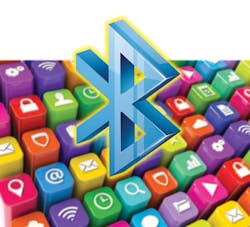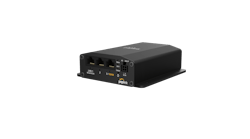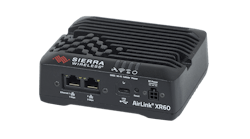Fading fast are the days when every alarm system required a landline into the home or business it protected. Increasingly, home and commercial alarm systems rely on an Internet connection, making security systems one of the central components of the ever-expanding Internet of Things (IoT).
Bluetooth was one of the early technology contenders for dominance in the IoT. In the world of appliances and home systems, early iterations of Bluetooth worked fine, but many looked to other sorts of Near Field Communications (NFC) for the security business. However, in its latest iteration, Bluetooth again is challenging for leadership as part of the IoT and therefore a key spot in the security business.
Bluetooth 4.2 is the latest disruptive technology related to the IoT. Ratified by the Bluetooth Special Interest Group in early December, it enables IP connectivity and resolves a key privacy issue. Now, unless they have enabled permission for beacons to communicate with their devices, users cannot be tracked.
Bluetooth’s Internet Protocol Support Profile (IPSP), which should earn final ratification about the time this article is published, will allow Bluetooth Smart sensors to access the Internet directly via IPv6. Bluetooth 4.2 will also herald a flood of new devices — including security-related ones — hooking up to the Internet.
Robert D. Carmichael, senior solutions engineer with Florida-based systems integrators Securadyne Systems, says Bluetooth 4.2 could possibly be a game-changer. “Bluetooth 4.2 includes some major security updates that were missing from previous versions,” Carmichael explains. “That, along with the increased communication speed and the addition of IPv6/6LoWPAN support makes Bluetooth even more attractive.”
Carmichael says he would expect to see a new breed of Bluetooth enabled products over the next year; however, it is not all fair winds and smooth sailing.
Shortage of Addresses?
Experts see a time not too far from today when IP addresses become scarce. Marc Blackmer, Cisco Systems product marketing manager of industry solutions says that day will certainly come when the rush to serve both industry and consumers with Internet of Things devices begins in earnest.
Don’t laugh. The United States “ran out” of phone numbers not that long ago and went to 10-digit dialing even for local calls. The dearth of IP addresses is real and looming; and the industrial piece has already begun. “We are before the revolution, on the cusp of a whole new adoption process,” Blackmer says. “Consumer products still have to happen. “
In short, alarm systems and other security devices will compete with refrigerators and thermostats for Internet access. As the number of smart homes continues to rise, monitoring such devices will be a part of the service package many alarm system providers will offer.
“It is everyday devices with direct connections to the Internet, from toasters up to big, complicated machinery,” explains Philip Gerskovich, senior vice president of Zebra Technologies. If a product was driven by a CPU unit or a computer chip before, he adds, now, for many devices, it is or will be Internet-connected.
The security industry has made the shift to increasing RMR with hosted and managed solutions. “As technology evolves, we see an increase in opportunities to own more of that market share. Today’s devices make that possible,” Carmichael says.
The Connected Device Explosion
Cisco Systems notes there are more devices connected to the Internet than there are people on the planet by a ratio of 1.5:1. Within five years, Cisco says, there will be 50 billion devices connected to the Internet, increasing that ratio to a little more than 7:1.
Internet Protocol version 4 (IPv4), which is currently used by the vast majority of Internet servers, delivers 4.3 billion addresses. This is not nearly enough to meet the IP address demand the IoT will create in just the next five years let alone into the more-distant future.
The newer Internet protocol — IPv6 — delivers 3.4 x 1038 addresses. That’s 340 undecillion addresses or, more precisely, 340,282,366,920,938,463,463,374,607,431,768,211,456 addresses.
With IPv6, Carmichael is not too worried about availability of numbers on the IoT going away or being used up. “We’ve already seen actions on part of the manufacturers to include IPv6 support in their latest firmware releases,” he says, noting that while IPv6 supports 340 undecillion addresses, The Internet Assigned Numbers Authority (IANA) has “only” released 42 undecillion addresses for public use on the Internet.
“That’s still more than enough for a very long time to come,” Carmichael says, adding that he is not too worried about those refrigerators, either. “If anything, this will broaden our solution scope,” he says.
If monitoring refrigerators along with intrusion alarms means greater RMR, security dealer/integrators will be sure to sign up.
Still, others see trouble down the road. “IPv4 has a limited number of addresses,” says Gerskovich, “and many people predict we will run out.” It’s not a problem yet, he says, because IP addresses are reused once the sites or the devices using them are taken offline.
In June 2014, Microsoft reported there were no more IPv4 addresses available in the United States. The company noted in its blog it would now be drawing on its global supply of IP addresses to keep things like its cloud service running.
More recently, the company announced its Windows Server 2008 and Windows Vista TCP/IP were redesigned to support both IPv4 and IPv6.
Those accessing the web via IPv6 are early adopters. Google tracks their numbers and pegs it at slightly more than 4.5 percent. The remaining 95.5 percent of the Internet users still use IPv4.
Evaluating Bluetooth
If we can agree that loss of addresses is not a near-term crisis, the current sticking point is the need for security dealers and integrators to come to an understanding of Bluetooth 4.2. According to the Bluetooth Special Interest Group, Bluetooth 4.2 increases the speed and reliability of data transfers between Bluetooth Smart devices. By increasing the capacity of Bluetooth Smart packets, devices transfer data up to 2.5 times faster than with previous versions. Increased data transfer speeds and packet capacity reduces the opportunity for transmission errors to occur and reduces battery consumption, resulting in a more efficient connection.
There is already a short list of manufacturers of Bluetooth solutions, and the technology is enabling mobile access control technology innovations such as gesture-based door lock control come alive. When looking at a new Bluetooth product and evaluating its effectiveness, Carmichael says dealer/integrators should ask themselves: “Is my decision affected by previous experience with other Bluetooth devices?”
Carmichael questions whether earlier Bluetooth versions were what most integrators would consider an Enterprise Class Solution. “I believe that’s what the industry is waiting for when it comes to this technology,” he says.
Alternatives
“NFC is still the most proven method available,” Carmichael maintains; however, he says this absolutely does not mean that Bluetooth solutions are out of the question. “As client demands push more towards the use of Bluetooth technology, we’ll begin to see Bluetooth being used on a much broader scale,” he says. With that usage will come the historical data and case studies that support engineered solutions.
Still, dealers should not make the assumption that all things are equal.
“Both Bluetooth and NFC devices need to be properly vetted to discover how the technologies are being embedded by the manufacturer,” Carmichael, a Ph.D. engineer, says. His work focuses on developing analytic techniques in advanced cryptologic communications, stochastic modeling, queueing theory, scheduling theory and game theory, and applying those techniques to application domains such as video surveillance, video analytics, access control, data networks and cloud computing.
“A thorough testing of the device, and supporting technologies (i.e. Software, SaaS, etc.), security and operational standards is essential,” he states.
The Thread, a new IP-based low-power wireless mesh networking protocol designed specifically for the home is another emerging standard to handle IoT devices. The Thread Group — an industry alliance chartered with guiding the widespread adoption of Thread — added Tyco to its Board of Directors in Late January, joining other security-related companies Nest Labs, Samsung Electronics and Yale Security. All are working to the goal os establishing the widespread adoption of Thread technology in the connected home.
What it Means for You
Out of the lab and down at the street level, the first and foremost challenge for dealers and integrators is to be open-minded when it comes to technology. Constant communication with existing suppliers is the key. “We find ourselves getting too comfortable with what we do and sometimes that can be blinding,” Carmichael says.
He suggests dealers make sure to spend time at the industry trade shows — and not just stopping by your current vendors. Meet with the new guys and see what they offer. “The industry may not always be ready for some of the innovative products you will see there, but one day they will,” he says. “You don’t want to be the last guy selling it.”
Curt Harler is a technology writer and a regular contributor to SD&I magazine. Reach him at [email protected].


